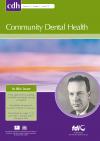Community Dental Health

- Cover Date:
- June 2010
- Print ISSN:
- 0265 539X
- Vol:
- 27
- Issue:
- 2
An assessment of nutritional information in oral health education leaflets
Introduction: Dental caries prevalence in UK children remains high and obesity, closely linked to Type 2 diabetes, is rising. Literature suggests that dentists may not give dietary advice due to a lack of clear and consistent guidelines. Objective: The aim of the study was to determine whether oral health education leaflets with a food and nutritional focus conform to existing UK national nutritional guidelines from the Department of Health (DoH), the Food Standards Agency (FSA) and the Committee on Medical Aspects of Food and Nutrition Policy (COMA). Method: A sample of 30 information leaflets, aimed at parents and children aged 3-16 years, was sourced during the winter of 2005-2006. A qualitative content analysis was carried out to identify key recommendations on type, frequency and quantity of food and drink and general diet-related health advice. Results: Most leaflets (21) promoted milk and water in agreement with nutritional guidelines. Timing of sugary food and drink to mealtimes (25) and decreasing frequency of ‘sugary’ e.g. non-milk extrinsic (NME) sugar containing foods (22) and drinks (25) reflected guidelines. Inconsistencies were, however, recorded in the leaflets. Five leaflets advised that frequency of consumption rather than the amount of sugary food or drink was important for oral health. This conflicts with nutritional guidelines, aimed at tackling obesity, to decrease both amount and frequency. There was conflicting advice on healthy snacks. Crisps were presented as ‘healthy’ by two leaflets; another two advised against snacking on dried fruit, conflicting with FSA guidelines that dried fruit contributes to “5 a dayâ€. Sixteen leaflets promoted cheese as ‘healthy’ with no limits on portion size; this could conflict with nutritional guidelines associated with percentage energy contribution of saturated fat to the diet. Conclusion: While there was agreement between leaflet content and nutritional guidelines, there were inconsistencies. Dental professionals should acknowledge these when selecting leaflets for lay dissemination.
Key words: Education, leaflets, nutrition, oral health.
- Article Price
- £15.00
- Institution Article Price
- £
- Page Start
- 81
- Page End
- 88
- Authors
- M.Z. Morgan, E. McFarlane, K.F. Stewart, M.L. Hunter, R.M. Fairchild
Articles from this issue
- Title
- Pg. Start
- Pg. End
- A health equity methodology for auditing oral health and NHS General Dental Services in Sheffield, England.
- 68
- 73
- Effectiveness of structured comprehensive paediatric oral health education for parents of children less than two years of age in Germany
- 74
- 80
- Reliability analysis of visual examinations carried out by schoolteachers and a dental assistant in the detection of dental caries.
- 89
- 93
- Caries experience and oral health behaviour among 11 – 13-year-olds: an ecological study of data from 27 European countries, Israel, Canada and USA
- 102
- 108
- Development of a measure of childhood information learning experiences related to dental anxiety
- 122
- 128
